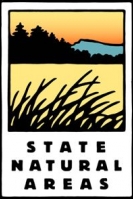State Natural Areas Visitor Guidelines
Guidelines and rules for visiting
Visitation and use
The majority of SNAs are remote and have few or no developed facilities. Some SNAs have vehicle access lanes or parking lots, but their accessibility may vary depending on weather conditions. Parking lots and roads are not plowed during winter. Hiking trails may be absent or consist of undeveloped footpaths.
Public use of SNAs is channeled in two directions: scientific research and compatible recreation. Natural areas serve as excellent outdoor laboratories for environmental education and formal research on biological communities and their component species. A permit issued by the SNA Program is required to conduct studies or collect specimens on SNAs. Natural areas are not appropriate for intensive recreation such as camping or mountain biking, but they can accommodate low-impact activities such as hiking, bird watching and nature study.
Rules governing the use of SNAs are found in Ch NR 45 Wis. Admin. Code.
Entrance fees
Entrance to SNAs owned by the DNR is free of charge, except for Parfrey's Glen, the Cambrian Overlook in the Dells of the Wisconsin River and SNAs located within State Parks and the Point Beach and Kettle Moraine State Forests. A Wisconsin State Parks and Forests vehicle admission sticker is required for these sites. We are unaware of any admission fees for SNAs owned by SNA program partners, including land trusts and other government agencies. However, please get in touch with the landowner for more information.
Refer to the table below for specific rules applicable to SNAs.
| Activity | Guidelines and rules for DNR-owned and most |
|---|---|
| Camping | Camping and fires are generally not permitted. However, some SNAs within state forests allow for primitive camping. Check with the respective state forest for details. |
| Climbing | Rock climbing and rappelling are prohibited, except at East Bluff SNA within Devil's Lake State Park and Dalles of the St. Croix River SNA. |
| Collecting | The collection of non-huntable animals, plants, fungi, rocks, minerals, fossils, archaeological artifacts, soil, downed wood or any other natural material, alive or dead, is prohibited except by SNA research permit. |
| Commercial use of state properties | Any person engaging in commercial filming or photography on state properties, including state natural areas, must acquire a commercial use permit. |
| Drones | Flying-related activities, including drones, hang-gliders and model airplanes, are prohibited. The SNA Program may issue permission to use drones for educational or research purposes. |
| Geocaching | Traditional geocaching is not permitted. Earthcaching and virtual caching are allowed in which a container is not hidden on the SNA. Contact the SNA Program for permission to establish a virtual cache. |
| Horses | Horseback riding is prohibited except on designated equestrian trails. |
| Hours | Most SNAs are open year around 24 hours a day unless otherwise noted in the specific SNA web page description or posted at the property. SNAs embedded within State Parks may have designated property hours. |
| Hunting | Most DNR-owned State Natural Areas are open to hunting by state regulations. Refer to the "recreation" tab on individual SNA web pages to determine if the DNR or a program partner owns the SNA. Hunting is generally allowed on SNAs owned by SNA partner organizations and agencies, such as The Nature Conservancy, U.S. Forest Service, and county forests. Still, specific rules vary depending on the partner's policies, and some may require a special permit. Refer to the "ownership" tab on individual SNA pages to determine if a partner owns the SNA and contact them directly for more information on hunting on their properties. Also, local township and municipal ordinances may regulate or prohibit hunting and the discharge of firearms on lands within their jurisdiction. |
| Pets | Pets are allowed on most DNR-owned SNAs, although they are prohibited in Parfrey's Glen. Dogs must be kept on a leash no longer than 8' unless used for hunting purposes in areas open to hunting. |
| Plants | Plants and plant parts, including seeds, roots, boughs, flowers, etc., may not be collected without a permit issued by the SNA Program. See below for guidelines on gathering edible wild plants. |
| Research | A permit is required for collecting specimens and conducting scientific research on SNAs. Please contact the SNA Program for a permit application. |
| Vehicles | Vehicles are prohibited on SNAs, including bicycles, ATVs, aircraft and snowmobiles, except on trails and roadways designated for use. Access to SNAs is only by foot, skis, snowshoes and watercraft. Some trails are wheelchair accessible. |
| Wild edibles | Edible fruits, edible nuts, wild mushrooms, wild asparagus and watercress may be removed by hand without a permit for personal consumption by the collector. "Edible fruits" means fleshy fruits from plants, including apples, plums, pears, blueberries, raspberries, blackberries, juneberries and strawberries harvested for human consumption. "Edible nuts" means walnuts, hickory nuts, acorns and other similar nuts from trees and shrubs. |

